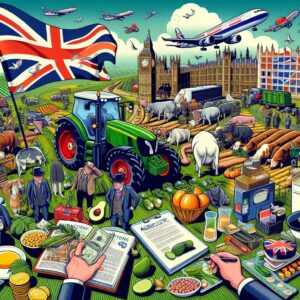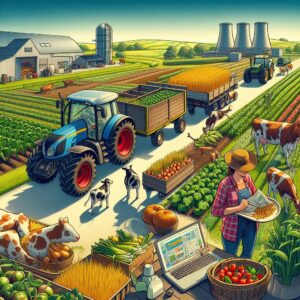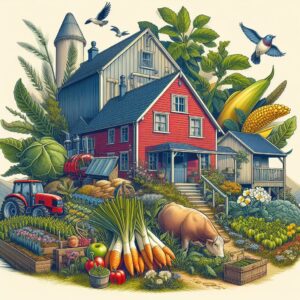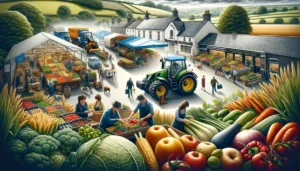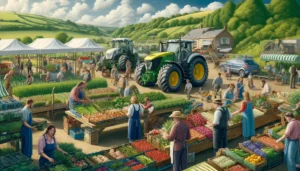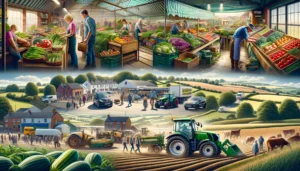Agriculture Businesses in the UK: A Comprehensive Analysis
Agriculture in the UK is a multifaceted industry that significantly impacts the nation’s economy, environment, and society. The agricultural sector includes a diverse range of businesses from traditional farming operations to cutting-edge agritech firms. This comprehensive analysis will delve into the political, social, and economic dimensions of agriculture businesses in the UK, offering detailed insights and practical advice for farmers and agribusiness owners.
Political Analysis
Government Policies and Regulations
- Agricultural Subsidies: Post-Brexit, the UK government has restructured its agricultural subsidies, moving from the EU’s Common Agricultural Policy (CAP) to the Environmental Land Management Scheme (ELMS). This shift aims to promote sustainable farming practices by rewarding farmers for environmental stewardship rather than production volume.
- Trade Agreements: The UK’s departure from the EU has led to new trade agreements with countries such as Australia, Japan, and the USA. These agreements have significant implications for agricultural exports and imports, influencing market dynamics and competitiveness.
- Food Security Policies: The UK government prioritizes food security, focusing on domestic production to ensure a stable food supply. Policies include support for technological innovation and resilience building in the agricultural sector.
- Environmental Regulations: Strict environmental regulations aim to reduce the agricultural sector’s carbon footprint. Farmers are encouraged to adopt practices that mitigate climate change, such as regenerative agriculture, conservation tillage, and precision farming.
Brexit Impact
- Labor Shortages: Brexit has exacerbated labor shortages in the agricultural sector due to reduced access to migrant labor from the EU. This shortage impacts harvesting, planting, and other labor-intensive tasks.
- Trade Barriers: New customs checks and regulatory differences have created barriers to trade with the EU, affecting the export of agricultural products. Farmers must navigate increased paperwork and compliance costs.
- Funding and Support: The loss of EU funding means UK farmers must rely on national support mechanisms. The transition to new funding schemes, such as ELMS, is crucial for financial stability.
Policy Recommendations
- Enhanced Support for Sustainable Practices: Increase funding for sustainable farming practices and provide technical assistance to farmers transitioning to environmentally friendly methods.
- Labor Solutions: Develop programs to attract and retain domestic labor, including training initiatives and improving working conditions in agriculture.
- Trade Facilitation: Simplify trade processes and negotiate favorable terms in new trade agreements to ensure market access for UK agricultural products.
- Innovation Incentives: Promote innovation through grants, tax incentives, and partnerships with research institutions to drive advancements in agricultural technology.
Social Analysis
Rural Community Dynamics
- Population Decline: Rural areas in the UK face population decline as younger generations move to urban centers for better opportunities. This trend impacts labor availability and community vitality.
- Aging Farmer Population: The farming community is aging, with many farmers nearing retirement. Succession planning is crucial to ensure the continuity of farming operations.
- Community Engagement: Strong community ties and support networks are vital for rural resilience. Initiatives such as farmers’ markets, cooperatives, and local festivals bolster community spirit and economic activity.
Education and Training
- Agricultural Education: Institutions such as Harper Adams University and the Royal Agricultural University offer specialized training and degrees in agriculture. These institutions are critical for equipping the next generation of farmers with necessary skills.
- Apprenticeships: Apprenticeship programs provide hands-on experience and practical training for young people entering the agricultural sector.
- Continuous Learning: Ongoing education and training programs are essential for farmers to stay updated on best practices, technological advancements, and regulatory changes.
Health and Well-being
- Mental Health: Farming can be a stressful occupation with long hours, financial pressures, and isolation. Mental health support services tailored for farmers are essential to address these challenges.
- Work-Life Balance: Encouraging a healthy work-life balance through better scheduling, labor support, and community activities can improve the overall well-being of farmers and their families.
- Health Services Access: Ensuring access to healthcare services in rural areas is vital for maintaining the health and productivity of the farming community.
Social Inclusion
- Gender Equality: Promoting gender equality in agriculture by supporting women farmers and encouraging female participation in leadership roles.
- Youth Engagement: Attracting young people to farming through education, mentorship programs, and highlighting the innovative and entrepreneurial opportunities within agriculture.
- Cultural Diversity: Embracing cultural diversity within rural communities and recognizing the contributions of migrant workers to the agricultural sector.
Economic Analysis
Market Trends
- Organic and Sustainable Products: Growing consumer demand for organic and sustainably produced food offers opportunities for farmers to diversify and access premium markets.
- Local Food Movement: Increased interest in locally sourced food supports the growth of farmers’ markets, CSA programs, and direct-to-consumer sales.
- Technological Advancements: Adoption of technologies such as precision farming, drones, and smart irrigation systems enhances productivity and efficiency, leading to better economic outcomes.
Financial Challenges
- Access to Capital: Securing funding for farm operations and investments is a significant challenge. Farmers need access to affordable credit, grants, and financial support programs.
- Input Costs: Rising costs of inputs such as fertilizers, fuel, and feed impact profitability. Efficient resource management and cost-saving measures are essential.
- Market Volatility: Fluctuating commodity prices and market demand require farmers to adopt risk management strategies and diversify income streams.
Economic Opportunities
- Diversification: Exploring diversified income streams, such as value-added products, agritourism, and renewable energy generation, can enhance financial stability.
- Innovation and Technology: Investing in agricultural technology and innovation to improve efficiency, reduce costs, and increase yields.
- Export Markets: Leveraging trade agreements and exploring new export markets to expand the reach of UK agricultural products.
Support Mechanisms
- Government Grants and Subsidies: Understanding and accessing available grants and subsidies for sustainable farming practices, technological adoption, and business development.
- Agricultural Cooperatives: Joining cooperatives to benefit from shared resources, collective bargaining, and marketing opportunities.
- Financial Planning Services: Utilizing financial planning and advisory services to manage finances, plan investments, and mitigate risks.
Self-Help Sections: Insight on Farming Support in the UK
Accessing Financial Support
- Government Grants: Explore grants available from the Department for Environment, Food & Rural Affairs (DEFRA) and other government bodies for various farming initiatives, including sustainability, innovation, and rural development.
- ELMS Funding: Understand the eligibility criteria and application process for the Environmental Land Management Scheme (ELMS) to receive payments for environmental stewardship.
- Bank Loans and Credit: Approach agricultural banks and credit unions that offer tailored loan products for farmers. Prepare a robust business plan to enhance your chances of securing funding.
Networking and Collaboration
- Join Farming Associations: Become a member of farming associations such as the National Farmers’ Union (NFU) to access resources, advocacy, and networking opportunities.
- Participate in Cooperatives: Engage with agricultural cooperatives to benefit from collective resources, shared equipment, and bulk purchasing power.
- Attend Agricultural Shows: Participate in events like the Royal Highland Show and the Great Yorkshire Show to connect with other farmers, learn about new products and practices, and showcase your produce.
Education and Training
- Enroll in Courses: Take advantage of courses and degree programs offered by agricultural colleges and universities to enhance your knowledge and skills.
- Online Learning Platforms: Utilize online platforms that offer webinars, tutorials, and courses on various aspects of farming and agribusiness management.
- Mentorship Programs: Seek out mentorship programs that pair experienced farmers with newcomers to provide guidance, support, and practical advice.
Health and Well-being Support
- Mental Health Resources: Access mental health support services tailored for farmers, such as those provided by the Farming Community Network (FCN) and RABI (Royal Agricultural Benevolent Institution).
- Work-Life Balance: Implement strategies to improve work-life balance, such as delegating tasks, hiring seasonal workers, and scheduling downtime.
- Community Activities: Engage in community activities and social events to build a support network and foster a sense of belonging.
Sustainability and Innovation
- Adopt Sustainable Practices: Implement sustainable farming practices such as crop rotation, cover cropping, and reduced tillage to improve soil health and reduce environmental impact.
- Invest in Technology: Invest in agricultural technologies like precision farming, smart irrigation systems, and drones to enhance efficiency and productivity.
- Explore Renewable Energy: Consider renewable energy options such as solar panels, wind turbines, and bioenergy to reduce energy costs and carbon footprint.
Practical Tips and Strategies
Financial Management
- Budgeting and Planning: Develop a detailed budget and financial plan to manage expenses, forecast income, and plan investments.
- Cost Management: Implement cost-saving measures such as bulk purchasing, resource sharing, and efficient use of inputs to reduce operational costs.
- Diversification: Diversify income streams through value-added products, agritourism, and renewable energy generation to enhance financial stability.
Marketing and Sales
- Direct-to-Consumer Sales: Explore direct-to-consumer sales channels such as farmers’ markets, CSA programs, and online sales to increase profit margins.
- Branding and Promotion: Develop a strong brand identity and promote your products through social media, farm tours, and participation in local events.
- Export Opportunities: Research and pursue export opportunities to expand your market reach and increase sales.
Risk Management
- Insurance: Invest in comprehensive insurance coverage to protect against risks such as crop failure, livestock disease, and natural disasters.
- Contingency Planning: Develop contingency plans to address potential challenges and disruptions, such as extreme weather events and market fluctuations.
- Diversification: Diversify crops and livestock to reduce risk and improve resilience to market and environmental changes.
Community Engagement
- Local Partnerships: Build partnerships with local businesses, schools, and community organizations to support local food systems and promote agricultural education.
- Community Events: Organize and participate in community events such as farm tours, workshops, and festivals to engage with the public and build community support.
- Education Initiatives: Support agricultural education initiatives in schools and communities to raise awareness about farming and inspire future generations of farmers.
Technological Adoption
- Stay Informed: Keep abreast of the latest technological advancements in agriculture through industry publications, conferences, and online resources.
- Evaluate ROI: Assess the return on investment for new technologies to ensure they align with your farm’s goals and financial capacity.
- Pilot Projects: Implement pilot projects to test new technologies and practices on a small scale before full-scale adoption.
Sustainable Practices
- Soil Health: Prioritize soil health through practices such as crop rotation, cover cropping, and reduced tillage to maintain productivity and resilience.
- Water Conservation: Implement water conservation techniques such as efficient irrigation systems, rainwater harvesting, and mulching to manage water resources sustainably.
- Biodiversity: Enhance biodiversity through agroforestry, polyculture, and wildlife conservation practices to create a balanced and resilient ecosystem.
Animal Welfare
- Humane Practices: Ensure that animal welfare is a priority by providing clean water, adequate food, proper shelter, and humane treatment.
- Pasture-Based Systems: Adopt pasture-based systems to allow natural behaviors and improve animal health and well-being.
- Preventative Healthcare: Implement preventative healthcare measures such as vaccinations, parasite control, and regular health checks to maintain animal health.
Future Outlook
Sustainability and Resilience
- Climate Change Adaptation: Develop and implement strategies to adapt to climate change, such as selecting climate-resilient crops, improving water management, and enhancing soil health.
- Sustainable Intensification: Focus on increasing agricultural productivity while reducing environmental impact through sustainable intensification practices.
- Circular Economy: Embrace circular economy principles by recycling and reusing agricultural waste, reducing waste generation, and creating closed-loop systems.
Technological Innovation
- Digital Agriculture: Adopt digital agriculture technologies such as IoT devices, sensors, and data analytics to improve decision-making, efficiency, and productivity.
- Robotics and Automation: Explore the use of robotics and automation to reduce labor costs, improve precision, and enhance operational efficiency.
- Biotechnology: Leverage biotechnology advancements to develop crops and livestock with improved traits such as disease resistance, drought tolerance, and enhanced nutritional value.
Policy and Advocacy
- Government Support: Advocate for supportive government policies that promote sustainable farming practices, provide financial incentives, and protect farmers’ interests.
- Research and Development: Support research and development initiatives to drive innovation and develop new technologies and practices for sustainable farming.
- Farmer Representation: Engage with farmer associations and advocacy groups to represent the interests of farmers and influence policy decisions.
Education and Training
- Lifelong Learning: Emphasize the importance of lifelong learning and continuous professional development for farmers to stay updated on best practices and emerging trends.
- Skill Development: Focus on developing essential skills such as financial management, marketing, and technological proficiency to enhance farm business management.
- Youth Engagement: Attract and inspire young people to pursue careers in agriculture through education, mentorship programs, and highlighting the innovative and entrepreneurial opportunities within the sector.
Community and Social Responsibility
- Local Food Systems: Support and promote local food systems to strengthen community resilience, reduce food miles, and enhance food security.
- Social Equity: Promote social equity and inclusivity in agriculture by supporting diverse and underrepresented groups, ensuring fair labor practices, and fostering a sense of community.
- Health and Well-being: Prioritize the health and well-being of farmers and farm workers by providing access to healthcare services, mental health support, and promoting a healthy work-life balance.
Conclusion
Agriculture businesses in the UK play a crucial role in the nation’s economy, environment, and society. By understanding the political, social, and economic dimensions of the agricultural sector, farmers and agribusiness owners can navigate challenges and seize opportunities to build resilient, sustainable, and profitable operations.
This comprehensive analysis provides valuable insights, practical tips, and strategies to support farmers in their journey toward sustainable farming practices. By focusing on financial management, marketing, risk management, community engagement, technological adoption, sustainable practices, animal welfare, and future outlook, UK agriculture can continue to thrive and contribute to the well-being of the nation and the environment.
Agri-Business in the UK Image Gallery


